Welcome back for more information from the American Soybean Association (ASA) and John Deere “Reach for the Stars” summer grower meeting in Bettendorf, Iowa, on July 20th at Scott Community College.
During the morning presentation, three of the Reach for the Stars winners offered experiences and observations they’ve had while using John Deere precision ag systems on their own farms. They were: David Oberbroeckling, Davenport, Iowa, Chris Von Holten, Walnut, Ill., and Curtis Claeys, Delmar, Iowa.
“We jumped in with both feet. We put the system on our 7120 Magnum sprayer tractor, then over to our MX for anhydrous, then back to the sprayer tractor, then to the New Holland for planting. We then did some side dress nitrogen strip tests and put it back into the sprayer tractor. We were moving that steering wheel a lot and it works on any color,” said Oberbroeckling. “We had good luck with it, and our AMS consultant (Vern Beninga with Elder Equipment Company) was a big help. I called him a lot, but that’s what he was there for. I think the real value in the whole program is the mapping, documentation and information because if you need to go back to it, it’s all right there. With all the rules coming down, this is going to be important.”
“We put it into the 4230 sprayer tractor, in the New Holland for some custom seeding work on alfalfa ground, then into the combine for wheat,” said Von Holten. “It’s great to see the maps as you’re going through the field and the moisture reports are really accurate. We’ll use it this fall when we strip till for increased accuracy.”
“We used the system for some primary tillage, spraying and fertilizing pastures and applying anhydrous. That is, in my mind, where you can make the most money with the system: anhydrous and spraying,” said Claeys. “We also used it for planting and mapping. We had it in three tractors, from a 4230 to an 8110. Moving the steering wheel is only about 20 minutes and we’re looking forward to using it in the combine this fall. We too had great support from our dealer. There are a lot of things that you just don’t realize the system can do.”
Visit the John Deere Web site for more information about the GreenStar™ 2 system.

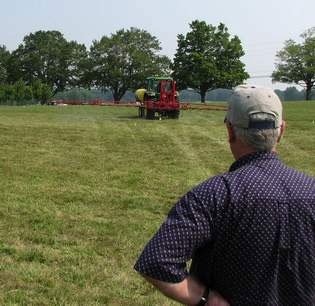 Scott Shearer, a University of Kentucky biosystems and agricultural engineering professor, demonstrated nozzle controls last week that use global-positioning system information to eliminate overlaps as sprayers with 90-foot-wide booms pass through Kentucky’s often oddly shaped fields.
Scott Shearer, a University of Kentucky biosystems and agricultural engineering professor, demonstrated nozzle controls last week that use global-positioning system information to eliminate overlaps as sprayers with 90-foot-wide booms pass through Kentucky’s often oddly shaped fields. 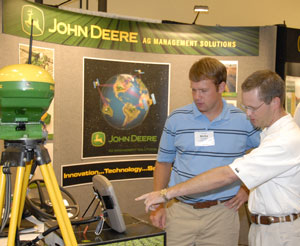 Precision ag management is a consulting specialty for some, like Nicky Burgess of Fullen Land and Management Partners in Ripley, Tennessee.
Precision ag management is a consulting specialty for some, like Nicky Burgess of Fullen Land and Management Partners in Ripley, Tennessee.
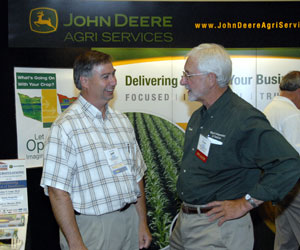 Precision soil sampling has come a long way, according to Tom McGraw of
Precision soil sampling has come a long way, according to Tom McGraw of 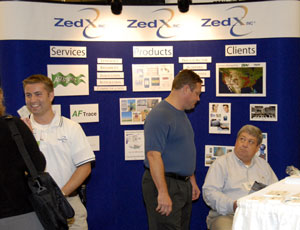
 “The real story on the 1870 seeders is the independently controlled hydraulic shank opener, Conserva Pak, which enables the placement of nitrogen, phosphorous, potassium, and sulfur-based fertilizers up to four inches away from the seed,” explains Detrick. “This positive vertical and horizontal separation of fertilizer and seed eliminates seeding damage caused by some fertilizer forms. This translates to more efficient placement of fertilizer, decreased seed damage, and optimized crop yields.”
“The real story on the 1870 seeders is the independently controlled hydraulic shank opener, Conserva Pak, which enables the placement of nitrogen, phosphorous, potassium, and sulfur-based fertilizers up to four inches away from the seed,” explains Detrick. “This positive vertical and horizontal separation of fertilizer and seed eliminates seeding damage caused by some fertilizer forms. This translates to more efficient placement of fertilizer, decreased seed damage, and optimized crop yields.”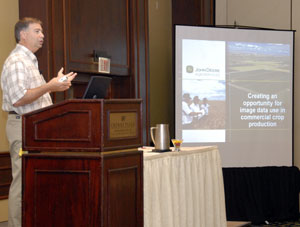 One of the presentations at last week’s InfoAg 2007 was titled “See Crop Variability Clearly,” on how remote sensing technology delivers aerial images that provide a unique view of crop and field variability.
One of the presentations at last week’s InfoAg 2007 was titled “See Crop Variability Clearly,” on how remote sensing technology delivers aerial images that provide a unique view of crop and field variability.